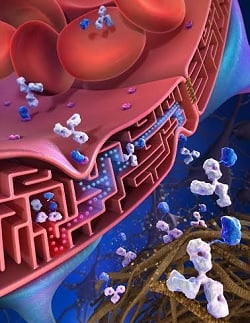 |
| Roche's delivery method uses the transferrin receptor pathway with a new binding mechanism to shuttle drugs into the brain.--Courtesy of Roche |
Crossing the blood-brain barrier is notoriously one of the most difficult challenges in drug delivery. But overcoming that obstacle can have vast implications for the treatment of high-profile market areas such as Alzheimer's, Huntington's and brain cancer. Now researchers at Roche ($RHHBY) have developed an antibody-based technique to "shuttle" large molecules into the brain, increasing exposure to the drug.
For Alzheimer's drugs in particular, which have suffered several big flops recently in later stages, this type of back-to-the-basics kind of research could begin a new, more successful wave.
Roche scientists published a study in the journal Neuron demonstrating that their method using a natural protein transport mechanism called the transferrin receptor pathway helped get Roche's experimental antibody gantenerumab into the brain to reduce amyloid plaque, thought to be a contributor to Alzheimer's disease.
"Over the last century, we have learned how to get small molecules into the brain, but large molecules remain a big challenge," Roche's head of neuroscience discovery, Anirvan Ghosh, told FierceDrugDelivery. "The transferrin receptor is a natural system that exists to get things to cross the barrier, so there's a lot of effort to engage this system."
In the past, other groups have used the transferrin receptor pathway, but Ghosh and fellow researchers have taken a different approach. By changing the binding mode of an antibody fragment to the receptor, the team allowed for more complete penetration of the barrier. The monovalent binding of the antibody to the receptor allowed for more penetration across the cells--known as trancytosis--as opposed to traditional bivalent binding, Ghosh said.
For this particular experiment, they used an antibody that targets the amyloid plaque in Alzheimer's patients. In the mouse model, the delivery method enhanced target engagement more than 50-fold, according to the abstract.
Roche recently dropped its program for its BACE inhibitor to treat Alzheimer's, an early-stage program in an arena that has seen many such projects hit the skids. Eli Lilly ($LLY) is another company that has taken blow after blow in the area. Lilly's solanezumab and Johnson & Johnson's ($JNJ) bapineuzumab are two of the more prominent flops.
So a new delivery method for Alzheimer's treatments could give new candidates the boost they need, Ghosh said. And Roche's preclinical transferrin receptor pathway could be used to treat other brain conditions such as Huntington's disease, but work is still being done in that area.
"The most exciting part about this mechanism is linking to other large molecules and other antibodies we want to explore," Ghosh said. "It's all very new, but we're developing it with the intent for it to become a new therapeutic modality."
- here's the release
- and here's the abstract